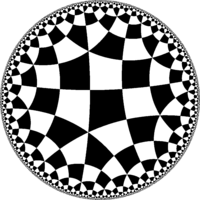Lambert quadrilateral

In geometry, a Lambert quadrilateral,[1] named after Johann Heinrich Lambert, is a quadrilateral three of whose angles are right angles. Historically, the fourth angle of a Lambert quadrilateral was of considerable interest since if it could be shown to be a right angle, then the Euclidean parallel postulate could be proved as a theorem. It is now known that the type of the fourth angle depends upon the geometry in which the quadrilateral lives. In hyperbolic geometry the fourth angle is acute, in Euclidean geometry it is a right angle and in elliptic geometry it is an obtuse angle.
A Lambert quadrilateral can be constructed from a Saccheri quadrilateral by joining the midpoints of the base and summit of the Saccheri quadrilateral. This line segment is perpendicular to both the base and summit and so either half of the Saccheri quadrilateral is a Lambert quadrilateral.
Examples
 *3222 symmetry with 60 degree angle on one of its corners. |
 *4222 symmetry with 45 degree angle on one of its corners. |
 The limiting Lambert quadrilateral has 3 right angles, and one 0 degree angle with an ideal vertex at infinity, defining orbifold *∞222 symmetry. |
See also
Notes
- ↑ the alternate name Ibn al-Haytham–Lambert quadrilateral, has been suggested in Boris Abramovich Rozenfelʹd (1988), A History of Non-Euclidean Geometry: Evolution of the Concept of a Geometric Space, p. 65. Springer, ISBN 0-387-96458-4, in honor of Ibn al-Haytham
References
- George E. Martin, The Foundations of Geometry and the Non-Euclidean Plane, Springer-Verlag, 1975
- M. J. Greenberg, Euclidean and Non-Euclidean Geometries: Development and History, 4th edition, W. H. Freeman, 2008.